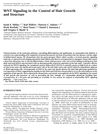Stimulation of Ectodermal Organ Development by Ectodysplasin-A1
May 2003
in “
Developmental Biology
”
TLDR Ectodysplasin-A1 is crucial for developing hair, teeth, and glands.
The study explored the effects of ectodysplasin-A1 (Eda-A1) overexpression in transgenic mice, revealing significant impacts on the development of ectodermal organs such as hair, teeth, and glands. The mice exhibited abnormal hair composition, including a shaggy appearance with curly whiskers and tail hairs, and disrupted hair cycling with a prolonged anagen phase. They also developed extra teeth, some without enamel, and supernumerary mammary glands with altered nipples. In contrast, overexpression of ectodysplasin-A2 (Eda-A2) did not produce any noticeable phenotype. The study, involving 10 K14-Eda-A1 transgenic founder animals and their progeny, suggested that Eda-A1 played a crucial role in the initiation and differentiation of ectodermal organs, while the function of Eda-A2 remained unclear.

